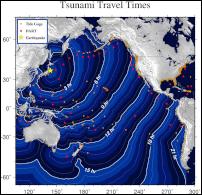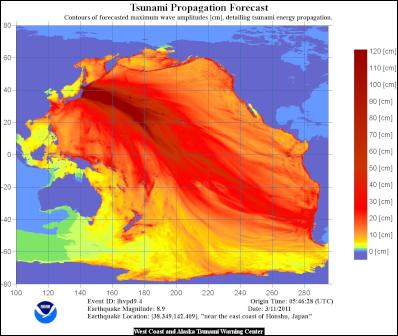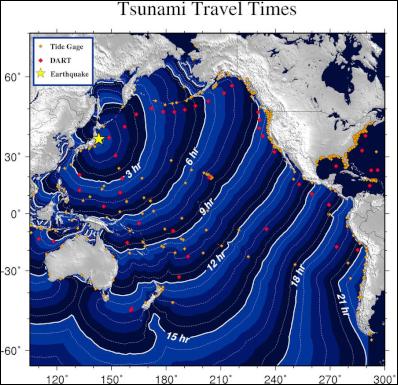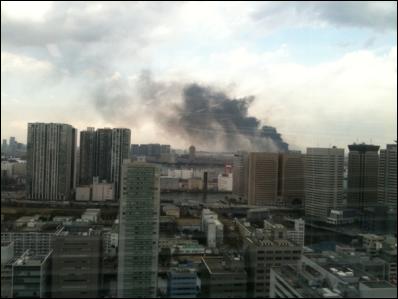SCOOP NEWS: Earthquake Aftermath Devastating For Japan - Explosion At Fukushima Nuke Power Plant
Report - By The Scoop Team
NZ Govt: NZ Foreign Affairs Urges Kiwis To Leave Tokyo & Northern Honshu
UPDATE MARCH 19: IAEA Calls For International Assistance To Resolve Japan Nuclear Crisis...
LIVE Chat by Spectator.co.nz
MARCH 19: Greater Openness Needed On Nuclear Crisis, UN Atomic Chief Tells Japan’s Leaders - The head of the United Nations agency that coordinates global nuclear safety told Japanese leaders today that they must provide faster and fuller information about the country’s nuclear reactor crisis amid reported criticism that they have not been as open as they should.
At the same time the International Atomic Energy Agency (IAEA) said it does not at the moment have health concerns either in Japan or more widely from released radiation, although that could change if the situation worsened. Click for more...
EARLIER: MARCH 18: VOA News reports that the IAEA says the situation at Japan's earthquake and tsunami-crippled nuclear reactor is "very serious" but there has been "no significant worsening" in the past 24 hours: "IAEA official Graham Andrew said at a press conference in Vienna on Thursday that radiation doses had risen "significantly" in some locations as far as 30 kilometers from the Fukushima plant, but that in the capital Tokyo they were well below levels considered dangerous to human health," VOA reports.
Science Media Monitor - Dr. Jim Smith, Reader in Environmental Physics at the University of Portsmouth, said: "The shape of any plume of material obviously depends on how high it goes - related to temperature of the damaged fuel - and weather. After Chernobyl, more volatile elements such as radiocaesium and radioiodine spread across Europe. Less volatile elements such as strontium-90 and plutonium were discharged as microscopic hot particles - tiny bits of reactor material - and were mainly deposited within 10 km of the plant.
"Rainfall washout is an important factor in depositing radionuclides to the ground. Japan should have an emergency response model which can predict real-time plume dispersion for, say, a loss of all the Iodine-131 in the fuel. This should be made public if it exists. I would be amazed if the plume resulted in big radiation doses in Tokyo, but modelling of the plume dispersion is needed to confirm this." Click for more...
Defense Sec. Gates Authorizes Humanitarian Funds for Japan - American Forces Press Service, WASHINGTON – Defense Secretary Robert M. Gates has authorized up to $35 million in initial Defense Department funds for humanitarian aid to Japan, a Pentagon spokesman said this morning. Marine Corps Col. Dave Lapan said the funding is in addition to $8 million in total planned aid to Japan from the U.S. Agency for International Development. Click for more...
IAEA Full Statement Follows Japanese Earthquake Update (17 March 17:55 UTC) Japanese authorities have informed the IAEA that engineers were able to lay an external grid power line cable to unit 2. The operation was completed at 08:30 UTC.
They plan to reconnect power to unit 2 once the spraying of water on the unit 3 reactor building is completed. The spraying of water on the unit 3 reactor building was temporarily stopped at 11:09 UTC (20:09 local time) of 17 March. The IAEA continues to liaise with the Japanese authorities and is monitoring the situation as it evolves.
MARCH 17: Japan Should Evacuate 50 Miles From Fukushima Reactors - USNRC - US Nuclear Regulatory Commission states that under the guidelines for public safety that would be used in the United States under similar circumstances, the NRC believes it is appropriate for U.S. residents within 50 miles of the Fukushima reactors to evacuate.
"Among other things, in the United States protective actions recommendations are implemented when projected doses could exceed 1 rem to the body or 5 rem to the thyroid. A rem is a measure of radiation dose. The average American is exposed to approximately 620 millirems, or 0.62 rem, of radiation each year from natural and manmade sources," USNRC states. Click for more...
MARCH 17: Australians Told To Leave Tokyo - ABC reports that Australians have been told to leave Japan's capital as the earthquake and tsunami-hit country hinges on the verge of nuclear disaster: "So far attempts to bring temperatures down in four reactors at the stricken Fukushima nuclear plant have failed and the US will fly a spy plane to the region to take a closer look at the reactors," ABC reports.
MARCH 17: Kiwis Encouraged Against Non-Essensial Travel To Japan - New Zealand's Ministry of Foreign affairs and Trade (MFAT) has warned New Zealanders from any non-essensial travel to Tokyo and north Japan, adding: "The Ministry’s travel advice for Japan has been revised to include further information, including advice from NZ’s National Radiation Laboratory on the nuclear situation. Please see www.safetravel.govt.nz for full details."
MARCH 17: Japan Nuclear Site Winds Direct Leaked Radiation Off Shore - AccuWeather reports winds at the ill-fated Fukushima nuclear power plant will remain essentially off shore through at least Friday, thereby steering any leaked radioactive matter out to sea and away from populated areas. Click for more...
MARCH 17: Reuters reports that the United States showed increasing alarm on Wednesday about "how Japan was handling its nuclear crisis, urging Americans to leave the area near an earthquake-crippled power plant and relying on U.S. experts for updates. "Without criticizing the Japanese government, which has shown signs of being overwhelmed by the crisis, U.S. officials admitted their call for American citizens to evacuate the area near the Fukushima nuclear plant went further than Japanese advice," Reuters reports.
MARCH 16: Scoop News Update: Japan - Nuke Power Plant Deteriorates Toward Possible Catastrophe
MARCH 16 News Round-Up: Reuters reports a reactor core at the Fukushima nuclear power plant may have been damaged elevating the risk of the nuclear crisis becoming a meltdown situation and the deterioration raising fears an explosion on the scale of Chernobyl may occur.
The International Atomic Emergy Agency (IAEA) head Yukiya Amano (see video top-right) said there is a possibility of core damage to reactor number two raising concerns Japan is heading toward a nuclear catastrophe.
Reuters also reports this morning that the U.S. military took "new steps to shield personnel from radiation spread by Japan's crippled nuclear plant on Tuesday, redirecting arriving warships to safer waters and telling some forces to limit time outdoors.
"But the U.S. Navy said it would not stop flying relief missions to help Japan after its devastating earthquake and tsunami, even as more U.S. flight crews were exposed to low-level - but higher than normal – radiation."
ABC reports Aftershocks continue to rock the nation but it is the unfolding nuclear crisis at the Fukushima nuclear power plant that has spread fear across the country: "In the pre-dawn, the ABC has seen people standing in the snow draped in blankets as they line-up outside petrol stations for fuel."
EARLIER UPDATES:
MARCH 14 Update: Explosion At Nuclear Reactor In Japan (See video above): Japanese state tv has showed pictures of an apparent explosion at the Fukushima nuclear powerplant. Russia Today (See video below) is reporting that radiation levels there are said to have increased rapidly. The plant has been facing a meltdown after the 8.9 magnitude earthquake hit the country on Friday. RT's Ivor Bennet reports from Tokyo.
MARCH 14: The UK's Telegraph reports that Japan, the world’s third richest country, has issued "an urgent international appeal for tents, blankets and other life-saving supplies to prevent the death toll rising beyond the current estimate of 10,000".
MARCH 14: The International Atomic Energy Agency (IAEA) reports following the failure of the high pressure injection system and other attempts of cooling the Fukushima nuclear power plant, Japanese authorities have informed the IAEA that accumulation of hydrogen is possible, rising fears of an explosion.
MARCH 14: Greenpeace Talks About Nuclear Reactor Dangers
MARCH 14: BBC reports that this is Japan's worst crisis 'since WWII' - Japan is experiencing its greatest hardships since World War II, Prime Minister Naoto Kan says, in the aftermath of the earthquake and tsunami, and a growing crisis at a nuclear plant. Police warn that the death toll in one of the worst-hit areas is likely to exceed 10,000.
Millions of survivors remain without electricity and authorities are stepping up relief efforts as the scale of the tragedy becomes clearer. About 310,000 people have been evacuated to emergency shelters, NHK says.
MARCH 13: Reuters reports that a second reactor at the Fukushima Power Plant has also lost its emergency cooling system at another reactor, Japan's nuclear power safety agency said on Sunday.
"The emergency cooling system is no longer functioning at the No.3 reactor at Tokyo Electric Power Co's Fukushima Daiichi nuclear power facility, requiring the facility to urgently secure a means to supply water to the reactor, an official of the Japan Nuclear and Industrial Safety Agency told a news conference," Reuters reported.
MARCH 13: Earlier, Japanese authorities informed the IAEA that radioactivity levels at a second nuclear power site, the Onagawa nuclear power plant, had returned down to normal background levels. The first (ie lowest) state of emergency was reported at the plant earlier on Sunday after an increased level of radioactivity was detected at the site boundary.
The first explosion at Unit 1 reactor at the Fukushima Daiichi plant occurred on Saturday outside the primary containment vessel (PCV), and Japanese officials said it was not inside the reactor. The plant operator, Tokyo Electric Power Company (TEPCO), has confirmed that the integrity of the primary containment vessel remains intact.
As a countermeasure to limit damage to the reactor core, TEPCO proposed that sea water mixed with boron be injected into the primary containment vessel.
IAEA noted that an initial increase in levels of radioactivity around the plant occurred earlier today, but these levels have been observed to lessen in recent hours.
MARCH 13: Evacuations are still underway around both affected nuclear plants. In the 20-kilometre radius around Fukushima Daiichi an estimated 170000 people have been evacuated. In the 10-kilometre radius around Fukushima Daini an estimated 30000 people have been evacuated. Full evacuation measures have not been completed. Click here for more...
MARCH 13: But as Stratfor reports, Japan’s Nuclear and Industrial Safety Agency (NISA) said March 12 that the explosion at the Fukushima Daiichi No. 1 nuclear plant could only have been caused by a meltdown of the reactor core, Japanese daily Nikkei reported. This statement seemed somewhat at odds with Japanese Chief Cabinet Secretary Yukio Edano’s comments earlier March 12, in which he said “the walls of the building containing the reactor were destroyed, meaning that the metal container encasing the reactor did not explode.”
MARCH 12: Reuters earlier reported radiation has leaked from an unstable Japanese nuclear reactor north of Tokyo on Saturday, the government said, after an explosion blew the roof off the facility in the wake of a massive earthquake.
The developments raised fears of a disastrous meltdown at the plant, which was damaged by Friday's 8.9-magnitude earthquake, the strongest ever recorded in Japan: "We are looking into the cause and the situation and we'll make that public when we have further information," Chief Cabinet Secretary Yukio Edano said.
MARCH 12: CNN is reporting that an explosion sent white smoke rising above at a nuclear plant where a massive earthquake and tsunami crippled cooling systems in northeastern Japan's Fukushima prefecture, Japanese public broadcaster NHK said Saturday, citing the country's nuclear and industrial safety agency.
MARCH 12: Voice of America reports a Japanese government spokesman has urged for calm following an explosion at one of two nuclear plants damaged in Friday's massive earthquake.
Japanese Chief Cabinet Secretary Yukio Edano says authorities are monitoring radiation levels at Fukushima, where smoke could be seen billowing out of the nuclear plant complex. Japanese media say radiation levels are more than eight times normal outside the plant. He urged people to follow earlier orders to evacuate the area 10 kilometers around the plant.
BREAKING NEWS - MARCH 11: EARLIER: The United States Geological Science site (www.usgs.gov) initially recorded the quake as a 8.8 magnitude but has since upgraded it to a 8.9 magnitude earthquake that was followed by a 7.1 magnitude aftershock.
Initial reports suggest loss of life and widespread damage of northern Japan. Fires have broken out in Tokyo's north-east.
Tsunami warnings have gone out to: Indonesia, Australia, New Zealand, Taiwan, Solomon Islands, Papua New Guinea, United States...

A tsunami marine warning is in effect for New Zealand: The tsunami warning will remain in effect until a cancellation message is issued by NZ Civil Defence.
The Pacific Tsunami Warning Centre (PTWC) has also issued a Tsunami Warning for New Zealand in response to the above earthquake. The New Zealand Tsunami Expert Panel assessment is that this is a marine threat only for New Zealand. A Marine Threat means strong and unusual currents are possible in the sea, rivers and estuaries. No land threat is expected at this time.
Tsunami generated waves are expected to reach Northland, New Zealand, at 6:14am (NZ Time), and the biggest threat expected to be West and East coasts of Northland.
People in coastal areas should:
1. Stay off beaches
2. Stay out of the water (sea, rivers and estuaries, including boating activities)
3. Do not go sightseeing
4. Share this information with family, neighbours and friends
5. Listen to the radio and/or TV for updates
6. Follow instructions of your local Civil Defence authorities.
A large earthquake has struck off the coast of Japan triggering a powerful tsunami in the north-west Pacific.
MCDEM and scientific advisors are closely monitoring the situation to determine whether a tsunami has been generated and to assess the severity of the threat to New Zealand. More information about this event will follow.
- Scoop News (Wellington) Japan Tsunami potential threat to NZ update warn officials
- NZ Govt New Zealand expresses deep concern about major earthquake
- For Tsunami Warning, See Japan Tsunami potential threat to NZ

Click for big version
Australian Science Media Centre - A major earthquake has occurred in Japan with a measured magnitude of 8.9. There have been reports of fires and damage in Tokyo and a tsunami has struck the Sendai area in the north-east of the country. See... RAPID ROUNDUP: Earthquake and tsunami in Japan – experts respond – version 1
The quake is reported as the largest to hit Japan since monitoring began over one hundred years ago. It was felt 2000 kilometres away in Beijing, China. Multiple numbers of people reported as dead.
New Zealand Minister of Foreign Affairs, Murray McCully said: “All New Zealanders are concerned to learn of this major quake which has caused extensive damage. Our thoughts are with the people of Japan at this moment as they endeavour to respond to this disaster.
“Japan has stood by our side in our time of need in the weeks following our tragedy in Christchurch. Our hearts go out to our friends in Japan," Mr McCully said.
The New Zealand Embassy in Tokyo is checking the whereabouts and safety of New Zealanders thought to be in the four most affected prefectures of northeast Japan.
New Zealanders with concerns about family in Japan should try to contact them directly in the first instance. If they cannot make contact and they are known to be in the northeast of Japan they should contact the Ministry of Foreign Affairs and Trade on 0800 432 111. If calling from overseas call +64 439 8000.
The earthquake struck approximately 125 kilometres off the coast of Honshu, Japan.
Magnitude 8.9
Date-Time: Friday, March 11, 2011 at 05:46:23 UTC
Location: 38.322°N, 142.369°E
Depth: 24.4 km (15.2 miles) set by location program
Region: NEAR THE EAST COAST OF HONSHU, JAPAN
Distances:
130 km (80 miles) E of Sendai, Honshu,
Japan
178 km (110 miles) E of Yamagata, Honshu,
Japan
178 km (110 miles) ENE of Fukushima, Honshu,
Japan
373 km (231 miles) NE of TOKYO, Japan.
More info to come...

Image courtesy of the NOAA Tsunami Warning Centre.

Image of Tokyo immediately after the quake.



 Binoy Kampmark: Warring Against Encryption, Australia Is Coming For Your Communications
Binoy Kampmark: Warring Against Encryption, Australia Is Coming For Your Communications Gordon Campbell: On Fast Track Powers, Media Woes And The Tiktok Ban
Gordon Campbell: On Fast Track Powers, Media Woes And The Tiktok Ban Binoy Kampmark: Censorship Wars, Elon Musk, Safety Commissioners And Violent Content
Binoy Kampmark: Censorship Wars, Elon Musk, Safety Commissioners And Violent Content Gordon Campbell: On The Public Sector Carnage, And Misogyny As Terrorism
Gordon Campbell: On The Public Sector Carnage, And Misogyny As Terrorism Ramzy Baroud: NATO’s Never-ending War: The 75-Year-Old Bully Is Faltering
Ramzy Baroud: NATO’s Never-ending War: The 75-Year-Old Bully Is Faltering Eugene Doyle: Joining AUKUS Not In NZ’s National Interest
Eugene Doyle: Joining AUKUS Not In NZ’s National Interest